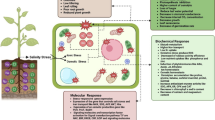Abstract
Artemisia (Artemisia lercheana Web.), common basil (Ocimum basilicum L.), and black cumin (Nigella sativa L.) plants grown in water culture until the stage of 4–5 true leaves were subjected to 10-min UV-B irradiation, treated with 100 mM NaCl, or subjected to the successive action of both stressors. The contents of proline, anthocyanins, flavonoids, soluble phenols, and carotenois were measured. Superoxide dismutase activity was also assayed. Experimental plants could tolerate UV-B irradiation due to the accumulation of phenolic compounds (anthocyanins, soluble phenols, and flavonoids). Anthocyanins contributed mostly in the defnse effect; their content in black cumin and common basil increased 3–5-fold after irradiation. Dynamics of the anthocyanin content in tested plants of all treatments indicates the activation of their biosynthesis by UV-B irradiation and suppression by salinity. Successive action of stressors resulted in synergism of their effects on accumulation of low-molecular compounds in artemisia and common cumin plants. When these plants were irradiated with UV-B and then treated with NaCl, they accumulated more low-molecular compounds than after separate treatment with these stressors, especially in Artemisia. Plant pretreatment with UV-B reduced the adverse action of salinity; this was manifested in the turgor maintenance in salt-treated plants after preliminary irradiation. For basil, salinity was the stronger stressor than UV-B, which was manifested in a decrease in the content of low-molecular compounds.
Similar content being viewed by others
Abbreviations
- SOD:
-
superoxide dismutase
References
Shao, H.-B., Chu, L.-Y., Lu, Zh.-H., and Kang, C.-M., Primary Antioxidant Free Radical Scavenging and Redox Signaling Pathways in Higher Plant Cells, Int. J. Biol. Sci., 2008, vol. 4, pp. 8–14.
Cakirlar, H., Cicek, N., Fedina, I., Georgieva, K., Dogru, A., and Velitchkova, M., NaCl Induced Cross-Acclimation to UV-B Radiation in Four Barley (Hordeum vulgare L.) Cultivars, Acta Physiol. Plant., 2008, vol. 30, pp. 561–567.
Prasad, Sh.M., Dwivedi, R., Zeeshan, M., and Singh, R., UV-B and Cadmium Induced Changes in Pigments, Photosynthetic Electron Transport Activity, Antioxidant Levels and Antioxidative Enzyme Activities of Riccia sp., Acta Physiol. Plant., 2004, vol. 26, pp. 423–430.
Albert, A., Sareedenchai, V., Helle, W., Seidlitz, H.K., and Zidorn, Ch., Temperature Is the Key to Altitudinal Variation of Phenolics in Arnica montana L. cv. ARBO, Oecologia, 2009, vol. 160, pp. 1–8.
Hao, G., Du, X., Zhao, F., Shi, R., and Wang, J., Role of Nitric Oxide in UV-B-Induced Activation of PAL and Stimulation of Flavonoid Biosynthesis in Ginkgo biloba Callus, Plant Cell, Tissue Organ Cult., 2009, vol. 97, pp. 175–185.
Borisova, T.A., Bugaje, S.M., Rakitin, V.Yu., Vlasov, P.V., and Kuznetsov, Vl.V., Heat Shock Increases the Tolerance of Plants to UV-B Radiation: 2. Ethylene and Carbon Dioxide Evolution, Russ. J. Plant Physiol., 2001, vol. 48, pp. 633–637.
Fredersdorf, J., Müller, R., Becker, S., Wiencke, Ch., and Bischof, K., Interactive Effects of Radiation, Temperature and Salinity on Different Life History Stages of the Arctic Kelp Alaria esculenta (Phaeophyceae), Oecologia, 2009, vol. 160, pp. 483–492.
Radyukina, N.L., Shashukova, A.V., Shevyakova, N.I., and Kuznetsov, Vl.V., Effects of Various Iron Supply on Oxidative Stress Development and Ferritin Formation in the Common Ice Plants, Russ. J. Plant Physiol., 2008, vol. 55, pp. 649–656.
Shlyk, A.A., Determination of Chlorophylls and Carotenoids in Extracts of Green Leaves, Biokhimicheskie metody v fiziologii rastenii (Biochemical Methods in Plant Physiology), Pavlinova, O.A., Ed., Moscow: Nauka, 1971, pp. 154–171.
Bates, L.S., Waldren, R.P., and Teare, I.D., Rapid Determination of Free Proline for Water Stress Studies, Plant Soil, 1973, vol. 39, pp. 205–207.
Zagoskina, N.V., Dubravina, G.A., Alyavina, A.K., and Goncharuk, E.A., Effect of Ultraviolet (UV-B) Radiation on the Formation and Localization of Phenolic Compounds in Tea Plant Callus Cultures, Russ. J. Plant Physiol., 2003, vol. 50, pp. 270–275.
Irani, N.G. and Grotewold, E., Light-Induced Morphological Alteration in Anthocyanin-Accumulating Vacuoles of Maize Cells, BMC Plant Biol., 2005, vol. 5, DOI 10.1186/1471-2229-5-7
Hazra, B., Biswas, S., and Mandal, N., Antioxidant and Free Radical Scavenging Activity of Spondias pinnata, BMC Complementary and Alternative Medicine, 2008, vol. 8, DOI 10.1093/ecam/nep072
Esen, A., A Simple Method for Quantitative, Semiquantitative, and Qualitative Assay of Protein, Anal. Biochem., 1978, vol. 89, pp. 264–273.
Miszalski, Z., Slesak, E., Niewiadomska, R., Baczek-Kwinta, R., Luttge, U., and Ratajczak, R., Subcellular Localization and Stress Responses of Superoxide Dismutase Isoforms from Leaves in the C3-CAM Intermediate Halophyte Mesembryanthemum crystallinum L., Plant Cell Environ., 1998, vol. 21, pp. 169–179.
Ramin, A.A., Effects of Salinity and Temperature on Germination and Seedling Establishment of Sweet Basil (Ocimum basilicum L.), J. Herbs, Spices, Med. Plants, 2005, vol. 11, pp. 81–90.
Kartashov, A.V., Radyukina, N.L., Ivanov, Yu.V., Pashkovskii, P.P., Shevyakova, N.I., and Kuznetsov, Vl.V., Role of Antioxidant Systems in Wild Plant Adaptation to Salt Stress, Russ. J. Plant Physiol., 2008, vol. 55, pp. 463–468.
Matysik, J., Alia, Bhalu, B., and Mohanty, P., Molecular Mechanisms of Quenching of Reactive Oxygen Species by Proline under Stress in Plants, Curr. Sci., 2002, vol. 82, pp. 525–532.
Author information
Authors and Affiliations
Corresponding author
Additional information
Original Russian Text © N.L. Radyukina, V.I. M. Toaima, N.R. Zaripova, 2012, published in Fiziologiya Rastenii, 2012, Vol. 59, No. 1, pp. 80–88.
Rights and permissions
About this article
Cite this article
Radyukina, N.L., Toaima, V.I.M. & Zaripova, N.R. The involvement of low-molecular antioxidants in cross-adaptation of medicine plants to successive action of UV-B radiation and salinity. Russ J Plant Physiol 59, 71–78 (2012). https://doi.org/10.1134/S1021443712010165
Received:
Published:
Issue Date:
DOI: https://doi.org/10.1134/S1021443712010165




